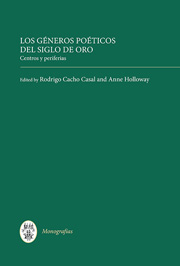Book contents
- Frontmatter
- Dedication
- Contents
- Índice de ilustrationes
- Índice de colaboradores
- Introducción: Géneros, centros, periferias
- I DEL CENTRO A LA PERIFERIA: GÉNEROS Y CONTRAGÉNEROS
- II AGUDEZA, RETÓRICA Y EMBLEMÁTICA
- III GÓNGORA Y SU ESTELA
- 8 Un epilio barroco: el Polifemo y su género
- 9 La imitación del discurso gongorino de la cetrería: primeras calas
- 10 Amante en durezas tierno: la Fábula de Polifemo de Antonia López de Vega
- IV POESÍA COLONIAL: EL NUEVO CENTRO
- V LA POESÍA Y SUS MARCOS: MANUSCRITOS, ANTOLOGÍAS, MISCELÁNEAS
- Bibliografía
- Índice onomástico
8 - Un epilio barroco: el Polifemo y su género
from III - GÓNGORA Y SU ESTELA
Published online by Cambridge University Press: 05 September 2013
- Frontmatter
- Dedication
- Contents
- Índice de ilustrationes
- Índice de colaboradores
- Introducción: Géneros, centros, periferias
- I DEL CENTRO A LA PERIFERIA: GÉNEROS Y CONTRAGÉNEROS
- II AGUDEZA, RETÓRICA Y EMBLEMÁTICA
- III GÓNGORA Y SU ESTELA
- 8 Un epilio barroco: el Polifemo y su género
- 9 La imitación del discurso gongorino de la cetrería: primeras calas
- 10 Amante en durezas tierno: la Fábula de Polifemo de Antonia López de Vega
- IV POESÍA COLONIAL: EL NUEVO CENTRO
- V LA POESÍA Y SUS MARCOS: MANUSCRITOS, ANTOLOGÍAS, MISCELÁNEAS
- Bibliografía
- Índice onomástico
Summary
Introducción
No cabe duda de que el Siglo de Oro literario presenció una evolución genérica poco menos que explosiva, hasta el punto de que el impulso género-generativo se puede calificar como característica constitutiva del período. Tanto el gran número de adaptaciones de la Poética aristotélica como la evidencia contenida en otros tipos de escritos de índole teórico-literaria — aprobaciones, panfletos, cartas— ponen de manifiesto la aguda conciencia con la que los autores y literatos áureos se planteaban la cuestión genérica y la importancia que le atribuían. Más aún, tal y como sugieren obras mayores del período como el Quijote, los Sueños o el Polifemo, el genio áureo se distinguía sobre todo por su aptitud para entrar en un género y redefinirlo desde dentro. De esto se sigue, lógicamente, que las obras canonizadas no surgieron de la nada. Al contrario: formaban parte de un conjunto de textos emparentados, hoy en su mayoría olvidados o considerados de secundaria importancia, que compartían unos rasgos taxonómicos comunes. Dentro de estos grupos, ciertas obras poseían alguna diferencia o calidad que las hacía destacar frente a las demás, asegurando su triunfo y su supervivencia. De este modo, consiguieron perdurar a través de los años y alcanzar la categoría de epítomes de sus respectivos géneros, influyendo en nuestra concepción actual de estos (de modo que no podemos hablar de la novela, por ejemplo, sin invocar el Quijote). Una aproximación posible a este desarrollo es la exaltación del genio singular; otra es la investigación sobre el género literario.
- Type
- Chapter
- Information
- Los géneros poéticos del Siglo de OroCentros y periferias, pp. 153 - 170Publisher: Boydell & BrewerPrint publication year: 2013



